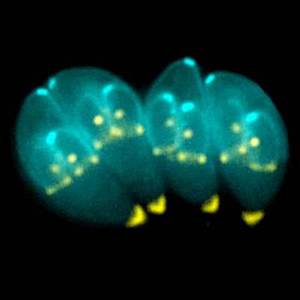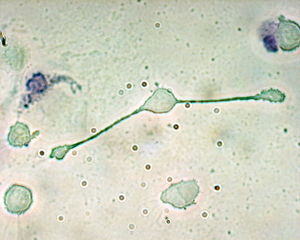A New Treatment for Toxoplasmosis

I have talked at some length about the possible link between toxoplasmosis and some forms of mental illness, but there is also another side to toxoplasmosis: the Toxoplasma gondii parasite infects nearly one-third of all humans: more than two billion people worldwide. In the United States alone, congenital toxoplasmosis occurs in an estimated 1 per 5,000 births a year and can cause severe vision loss, brain damage and even death. The human cost is incalculable, and in dollars and cents, it has been estimated that the annual cost of caring for these children may exceed $1 billion.
Toxoplasma gondii is carried by some cats and it is said that an infected cat can excrete up to 20 million oocysts over a period of two weeks, and every single oocyst is infectious. They are tenacious and can remain infectious in water for up to six months and in warm moist soil for a year of more.
Toxoplasma infects humans through three main routes:
- Consumption of undercooked, infected meat
- Ingestion of T. gondii oocysts in food, through accidental contamination from cat litter
- Finally, a newly infected pregnant woman may pass the infection to her fetus, hence the warning that pregnant women should not clean the cat box
Not only is toxoplasmosis the most common parasitic infection in the world, but also it can cause particular problems in people with compromised immune systems, for instance people with cancer, autoimmune disease, AIDS or transplant recipients.
It is even possible for people with normal immune systems to suffer major organ damage from chronic infections. Eye disease leading to loss of sight can be caused both a primary infection and as a result of infection transmitted from mother to child. Damage to other organs has recently caused deaths among otherwise healthy young people during epidemics in Surinam and French Guiana.
The parasites that cause malaria are related to Toxoplasma gondii, and a new drug that will soon enter clinical trials for the treatment of malaria also appears to be 10 times more effective than the current gold-standard treatment of toxoplasmosis, a combination of the drugs pyrimethamine and sulfadiazine.
In the March issue of PLoS Neglected Tropical Diseases, a research team based at the University of Chicago Medical Center reports that the drug, known as JPC-2056, is extremely effective against Toxoplasma gondii, both in cell culture and in mice, and apparently without the toxicity associated with the current standard treatment.
The drug works inhibiting the action of the from of the enzyme dihydrofolate reductase (DHFR) that is produced by the family of parasites that includes those that cause toxoplasmosis and malaria, and in cell culture studies, the drug appears actually to kill the parasite, rather than simply preventing its replication. This is very important: not only do most of the current medications have a good many side effects, they have little effect on Toxoplasma during certain phases of its life cycle. It can hunker down in the quiescent cystic phase and wait until the antibiotics are gone.
Rima McLeod, professor of ophthalmology and specialist in infectious diseases at the University of Chicago said,
“JPC-2056 has the potential to replace the standard treatment of pyrimethamine and sulfadiazine. Taken by mouth, is easily absorbed, bioavailable, and relatively nontoxic. In tissue culture and in mice, it was rapidly effective, markedly reducing numbers of parasites within just a few days.”
JPC-2056 is not a new drug. It was developed in the late 1980s by teams led by Wilbur Milhous and Dennis Kyle of the Walter Reed Army Institute for Research and David Jacobus of Jacobus Pharmaceutical Company. The original version was quite toxic, but the researchers found ways to reduce the toxicity and developed an oral version of the drug. Clinical trials using JPC-2056 to treat malaria are scheduled to begin later this year.
A Virus Linking Depression, Aging and Heart Disease

We have known for a long time that there are close links between depression, aging and heart disease, but the nature of the link has remained elusive. Most of the smart money has been on inflammation, but there could be other candidates.
New research in the journal Brain, Behavior and Immunity has linked an increase in two inflammatory proteins in the immune system with a latent viral infection and proposes a chain of events that might accelerate cardiovascular disease. It is possible that the same process may be involved in a number of other ailments that can afflict us, as we get older. The findings also suggest that chronic depression may play a key role in initiating the cascade that can lead to the development of coronary artery disease.
It has been known for some time that increased levels of the proinflammatory cytokines, TNF-α and IL-6, predict mortality and morbidity. High levels of each of them are found in the plasma and in atherosclerotic lesions of people with cardiovascular disease.
The levels of IL-6 in the body increase as the immune system ages. Some of the IL-6 is generated by immune cells – macrophages – that go to the site of an infection or injury. Earlier work by the team also showed that increases in psychological stress and depression could substantially raise the levels of IL-6 and TNF-α in the body.

Increased stress and depression can also trigger latent viruses to reactivate and begin reproducing inside cells. The viruses of greatest interest are some herpes viruses such as the Epstein-Barr virus (EBV). We know that up to 90% of the people in North America have been infected by EBV by the time they are adults.
If EBV begins to multiply in cells in the body, it produces a protein called dUTpase that, in turn, can stimulate macrophages to make yet more IL-6.
The researchers developed a model to test these linkages by using endothelial cells that line the inside of veins in umbilical cord tissue. I spent years working with these cells myself, and they provide an excellent substrate for examining vascular responses and the interaction between blood vessels and macrophages when exposed to the virus as well as the dUTpase protein.
As expected, the production of IL-6, as well as TNF-a, were increased just as they would be as part of the inflammatory process in the body. Such chronic incidents of inflammation are integral to the onset of atherosclerosis and an array of other diseases.
This work suggests a new way of thinking about how vascular diseases develop. We carry around these latent herpes viruses in our bodies virtually all our lives and periodically they can hurt us as we age, develop depression or, perhaps a nutritional imbalance.
Taken together with the recent data on the physical effects of loneliness, if you want to live a long and healthy life:
- Watch you mood: depression can kill you
- Stay socially engaged: loneliness can be fatal
- Maintain a balanced diet
- Take some physical exercise every day
- Learn – and practice! – some simple stress management techniques. You can obtain some at RichardGPettyMD.com
T'ai Chi Ch'uan and Shingles

Shingles can be a particularly nasty problem, and treatment can be tough. It should be called herpes zoster, and it is caused by re-activation of varicella zoster virus (VZV) that causes chickenpox.
A new study from the Norman Cousins Center for Psychoneuroimmunology at UCLA, has shown that t’ai chi therapy can stimulate the immune system of patients with shingles to levels comparable to those achieved using a vaccine against VZV.
It was a controlled trial in which the researchers randomized 112 healthy adults aged 59 to 86, who had a history of varicella infection, to Tai Chi Chih (TCC, a simplified, standardized form of tai chi) or health education (HE) for 25 weeks. After 16 weeks of intervention, subjects were vaccinated against VZV. The results of blood tests showed that TCC alone increased immunity against VZV by an amount comparable to that induced by varicella vaccine in the HE group.
It was interesting that the effects of the two were additive; TCC, together with varicella vaccine, produced a substantially higher level of immunity against VZV than vaccine alone, raising it to levels usually observed in adults 30 years younger.
The tai chi group also showed significant improvements in scores for physical functioning, bodily pain, vitality, and mental health.
Regular readers will recall another report from this research group, indicating that TCC reduced the activity of the sympathetic nervous system. The two studies both show that there is something special going on: the practice does not only calm the mind and body, it also regulates parts of the body that are normally beyond voluntary control.
There are clearly plenty of reasons for taking up t’ai chi, though now we shall have to see whether other forms of t’ai chi can achieve the same results.
Goldilocks and the, err, Vitamins

We are often told that we should take much higher amounts of many vitamins than the doses that are usually recommended.
The late Linus Pauling was one of the most famous proponents of the idea of using huge amounts to Vitamin C to present colds and an array of other health problems. Over the years I have heard enough recommendations to confuse anyone: and one of my degrees is in biochemistry! The only answer with so many conflicting pieces of advice is to do some good research.
Vitamin A is an important fat-soluble vitamin involved in the maintenance of many of many key systems in the body. The recommended daily allowance for vitamin A is 5000 international units (IU) for adults and 8000 IU for pregnant or lactating women.
Vitamin A deficiency is one of the major nutritional problems worldwide and it threatens the survival and health of millions of children. According to a report published in 2002, 127 million preschool children and 7·2 million pregnant women are deficient in vitamin A.
Vitamin A deficiency can cause night blindness, drying and degeneration of the cornea that can lead on to total blindness, as well as impairment of the immune system.
Children living in regions where vitamin A intake is insufficient need to receive adequate amounts of vitamin A through breastfeeding, together with improved diets, food fortification and supplementation with vitamin A.
Providing vitamin A supplementation in countries where there is a deficiency of the vitamin has been proven to decrease mortality. As a result, most developing countries have adopted a standard World Health Organization (WHO) dosing schedule for vitamin supplementation, which calls for 200,000 IU to mothers early postpartum and then 200,000 IU every 4 to 6 months. For infants, the recommendation is 100,000 IU at 9 months and 200,000 IU at 12 months.
However, in 2002 the International Vitamin A Consultative Group (IVACG) Annecy Accord recommended a new high-dose regimen for mothers and infants which includes a doubling of the initial postpartum dose for mothers, and adding 50,000 IU at 2, 3 and 4 months for infants.
An article just published in the Lancet indicates that this high dose protocol does not have any benefit over the older recommendation.
Professor Andrew Prentice and a team of researchers at the International Nutrition Group at the London School of Hygiene and Tropical Medicine in London and colleagues, studied 220 women-infant pairs in an area of moderate vitamin A deficiency in Gambia. One group received the WHO recommended dose, while the other received the IVACG recommended dose.
They measured blood plasma levels of vitamin A, the incidence of Helicobacter pylori infection, how many of them had pneumococcus in the nasopharynx and the integrity of the infants’ intestines.
The problem is that too much vitamin A can also create problems, including nausea and vomiting, jaundice, irritability, anorexia, blurred vision and worst of all, increased intracranial pressure that can cause headaches, drowsiness and even death. These are not such big problems in well-nourished adults living in the Western world, but in malnourished infants, particularly if they are also being vaccinated, this can be a big problem.
There is one specific occasion when a high dose of Vitamin A can be helpful: if a child in a deficient area gets severe measles, the WHO recommendation is that two doses of 200,000 IU should be given to the child. It is easy to forget that in some parts of the world measles can be a killer.
The authors of the article, as well as an accompanying editorial suggest that we should be looking at lower, rather than higher doses of vitamin A.
The editorial is by Professor Bernard Brabin of the Child and Reproductive Health Group in Liverpool, England and he finishes by saying,
“Future trials should emphasize the importance of exclusive breastfeeding, because early feeding with formula milk might reduce potential benefits from early supplementation with vitamin A in infants.”
This story shows us once again the extreme importance of having just the right amount of a vitamin or nutrient.
If someone claiming to be an expert in nutrition or vitamin therapy tells you to “take as much as you want” of anything, please be careful.
Just remember the story of Goldilocks and the Three Bears….
Resistance Genes in the Food Supply

Your humble reported has been interested in nutrition since he was knee high to a puppy, and he has also been worried about the consequences of pesticides and other artificial chemicals getting into the food chain. He has also been worried about feeding all kinds of artificial potions to animals. Surely they would eventually turn up in humans, and we have little idea about all the things that they may do. It is also a worry that antibiotic resistance in humans could be passed on to bacteria in animals.
Some of these fears were born out at a conference – the 107th General Meeting of the American Society for Microbiology (ASM) – in Toronto this week.
A paper presented by Hua Wang of the Ohio State University suggests that the administration of antibiotics to animals could be contributing to the continuing rise of antibiotic-resistant infections in humans
The problem is a process known as horizontal gene transfer, in which bacteria that are in close proximity to each other can share genetic information, including genes that code for antibiotic resistance. Horizontal gene transfer between disease-causing bacteria has been known for years as an important avenue for the exchange of antibiotic-resistance genes among bacteria in hospitals. We all carry bacteria on and in our bodies. Some are beneficial, and help in things like digestion. Others are simply “passengers,” and we call these “commensal” bacteria.
Research has also already demonstrated that pathogenic bacteria have the ability to engage in horizontal gene transfer with the otherwise harmless bacteria that we all carry in our bodies. What concerns us is that these normally benign commensal bacteria have an enormous and diverse gene pool. That increases the likelihood of gene transfer. Some commensal bacteria exchange genetic information extremely quickly. That was helpful to the bacteria during evolution, but may be producing a boatload of problems for us today.
Dr Hua said:
“We have demonstrated not only that organisms carrying such intrinsic mechanisms have the potential to become an important reservoir for antibiotic resistance genes but, more importantly, that these intermediate organisms can disseminate antibiotic resistance genes in subsequent events much more effectively than the parental donor strain.”
“Once we no longer limit ourselves to food borne pathogens and look at commensal bacteria, we will find that the magnitude of antibiotic-resistant bacterial contamination in the food chain is tremendous.”
In a study published last year, she and her colleagues tested a range of ready-to-eat food samples that they purchased from several grocery chain stores. They included seafood, meats, dairy, deli items and fresh produce. With the exception of processed cheese and yogurt, antibiotic-resistance gene-carrying bacteria were found in many food samples that they examined.
The problem is not just confined to the food supply. Recent studies have shown antibiotic resistance genes in bacteria in the digestive tract of young infants. Since these children were still being breast- or formula-fed and had not yet eaten solid food, they must have acquired these genes somewhere other than the food supply. This suggests that resistance genes from the environment had somehow got into the infants.
Antibiotic resistance is a huge and ever-growing problem. For years now, many of us have worried about the over-prescribing of antibiotics when they are not needed. For example viruses cause the vast majority of sore throats, and few viruses respond to antibiotics. Yet patients often feel cheated if they do not leave a doctor’s office clutching a prescription. The result has been increasing numbers of resistant bacteria. When you really need an antibiotic, it may no longer be effective. Now we have another mechanism by which our actions have caused a problem that could quite literally be the death of us.
It’s Not Just Kissing
Once upon a time Marilyn Monroe is supposed to have said, “So what’s wrong with sleeping with lots of people? You can’t get cancer from it.”
The quotation may be apocryphal, but the facts are not: we now know full well that there are viruses that can be sexually transmitted that may in turn increase the risk of getting cervical cancer. Hence all the talk about Gardasil, the new vaccine against some of the main culprits: strains of the human papillomavirus (HPV) types 16, 18, 6, and 11. HPV types 16 and 18 cause about 70% of HPV-related cervical cancer cases.
It was only a matter of time before someone put two and two together and asked the question whether the viruses might be involved in cancer if they end up in other parts of our anatomy.
After all the revelations concerning a former President, it seems that over the last ten years there has been a sea-change in attitudes. According to surveys, many young people now regard oral sex as nothing more significant than kissing.
On many levels, that is sad.
Anyone able to see the larger picture will be upset to see that complex matters of human relationships, feelings of self-worth and transcendence are being reduced to a branch of gymnastics. This is not at all a puritanical view: any kind of sexual activity is complex and multi-faceted. And now there is some new evidence to suggest that oral sex with multiple partners can carry a substantial risk of developing cancer of the throat.
According to a study published in the New England Journal of Medicine people who have oral sex with 5 or more partners during their lifetime have a much greater chance of having throat cancer, The researchers suspect that the cause is a well known strain of the human papillomavirus (HPV) that is linked to a number of anogenital cancers.
Dr Maura Gillison and a team of collaborators from the Johns Hopkins Bloomberg School of Public Health in Baltimore, Maryland conducted the research.
Scientists already knew that HPV was doing something at the molecular level to help trigger a type of throat cancer known as oropharyngeal squamous-cell carcinoma, but consistent epidemiological evidence was still missing.
The researchers recruited 100 patients with newly diagnosed oropharyngeal cancer and 200 control patients without cancer in a hospital-based case controlled study. They used a statistical method called logistic regression to look for links between results from the patients’ blood and saliva samples and lifestyle variables such as their sexual behavior, consumption of alcohol and smoking habits. Getting honest and accurate lifestyle data is always tough, particularly when asking about sex, so this data was collected using an anonymous questionnaire.
The results showed that:
- Patients who had a lifetime number of 6 or more oral-sex partners were 3.4 times more likely to have oropharyngeal cancer
- Those who had 26 or more vaginal-sex partners during their lifetime were 3.1 times more likely to have oropharyngeal cancer.
- The link became stronger as the number of lifetime oral and vaginal sex partners went up.
Oropharyngeal cancer was linked with oral infection with HPV type 16 (HPV-16), with any of the 37 types of HPV, and with having been exposed in the past to HPV. That was determined by measuring for antibodies to the HPV-16 L1 capsid protein. The statistics were impressive. What is known as the odds ratio for these three events were found to be 14.6, 12.3 and 32.2 respectively.
DNA from HPV-16 was found in 72 per cent of tumor specimens and 64 per cent of patients tested positive for presence of one or more cancer-related proteins produced by HPV-16. (These are known as oncoproteins E6, E7, or both).
The results suggested that once the link with HPV is present, there is no added risk from tobacco use and alcohol consumption, usually regarded as the highest risk factors for this type of throat cancer.
The researchers suggest that HPV "drives" the cancer and once the cell is sufficiently disrupted to cause cancer, the impact of tobacco and alcohol is unlikely to contribute any more risk.
The researchers concluded that:
"Oral HPV infection is strongly associated with oropharyngeal cancer among subjects with or without the established risk factors of tobacco and alcohol use."
In an accompanying editorial, Dr Stina Syrjänen from the University of Turku in Finland suggested that this study raises important clinical and public health issues.
For instance:
- Should heavy smokers and drinkers be screened for HPV-related throat infection?
- Should throat cancers with a suspected HPV origin be treated differently form those with no HPV link and most likely caused by smoking and drinking?
- And the question that must be in the minds of many currently focused on the HPV vaccination debate: would HPV vaccination give people protection against some throat and mouth cancers?
Non-pharmacological and Lifestyle Approaches to Attention-Deficit/Hyperactivity Disorder: 5. Exercise, Environment and Sleep

One of the most valuable things to do to help children or adults with ADHD is to help them to structure their time.
All the approaches that we have already discussed, from medications to diets, herbs and homeopathy are all tools designed to help people get to the point where they can create, accept and maintain more structure in their lives. Exercise, the environment and regular sleep are all essential contributors.
Exercise
Aerobic exercise may be particularly helpful for people who also have a mood disorder or anxiety probably by reducing inflammatory mediators in the blood.
There is a movement therapy called eurythmy that was developed by Rudolf Steiner. It is quite popular in central Europe, and there has been a report that it could help children with ADHD.
Environment
There is evidence that children with ADHD do better if they are outside, and even being a green room seems to help them.
There are plenty of anecdotes about children and some adults with ADHD improving if they have classical or New Age music in the background. Paradoxically some like and claim benefit from “heavy metal.” There is recent evidence from New Zealand indicating that music therapy may contribute to the reduction of a range of ADHD symptoms in adolescents, as it does in younger children. With the advent of the iPod, it is easy to make a playlist of music that helps attention and concentration.
The data on the effect of watching television, computer time or playing video games is a mixed bag. There are people who say that children under the age of three should not watch television at all, and the American Academy of Pediatrics recommends that children under the age of 2 years should watch no television, and that television time should be limited to less than 2 hours daily in older children. The research data has not produced a clear answer one way or the other. Some of the most recent research does suggest a link between the amount of time that children spend
watching television and attention-deficit/hyperactivity disorder, but
it remains unclear as to whether elevated levels of television viewing
are the cause or result of ADHD symptoms. Other researchers have failed to find a connection. The best thing is to play safe and to keep television viewing to a minimum: there are so many other things for a child to be doing.
There have been questions about whether other environmental factors, particularly lead, mold and Candida could cause ADHD.
Lead toxicity is well-known to cause neurological problems, but studies of a link between lead levels and ADHD have usually failed to find a link, and in a study in which children with minimally elevated lead levels were given a drug – penicillamine – to remove lead, there was no change in ADHD rating scores. So it is unlikely that lead is a factor in most children.
Because of the high rates of allergies in people with ADHD, there have been attempts to see if mold or other environmental pollutants could be causing ADHD. So far the data has drawn a blank.
Another environmental factor that has been look at is the yeast Candida albicans. It can produce nasty infections in people with compromised immune systems. But in addition, some people have claimed that Candida infections can cause an array of medical problems, including ADHD-like symptoms. People who are thought to have Candida have been treated with diets as well as the antifungal agent nystatin, with mixed results. It would be good to do a formal study of Candida in ADHD and see if there is a link and if treatment helps. So far we just do not have one.
Sleep
Sleep disturbances are extremely common in ADHD. They often get better once an individual is treated, but it is still a good idea to practice good sleep hygiene.
- Stress management
- Exercise a couple of hours before retiring
- Keeping mentally stimulated until it is time for bed
- Though we want to have a regular bedtime and bedtime ritual, to begin with don’t go to bed until you are tired
- No caffeine, alcohol or nicotine after 6pm. (Preferably, of course, no nicotine ever!!) {Remember that many over the counter painkillers contain caffeine, as does chocolate}
- Try to keep the bedroom atmosphere relaxing, and establish a sleep ritual
- Keep the room quiet and dark
- If you like aromatherapy, lavender and chamomile are usually best
- If you cannot sleep, get up and do something relaxing: struggling to go to sleep is virtually impossible.
- Do not have a television in the bedroom. Bedrooms should be reserved only for sleep in children and for one other activity in adults
- Always get up at the same time in the morning, to try and re-set your brain, and as soon as you get up, be exposed to as much bright light as possible
Here Comes the Sun: To Screen or Not To Screen?

I have been worried to see some people – all, I think, without scientific training – proclaiming that there is no need to protect ourselves against the sun because there is no evidence that sulight causes any health problems.
Ultraviolet radiation (UVR) from the sun has been part of the environment since the first cells began to form. When we discuss the effects of UVR on human health and the environment, the range of UV wavelengths is often subdivided into:
- UVA (400–315 nm), also called Long Wave or “blacklight”
- UVB (315–280 nm), also called Medium Wave
- UVC (< 280 nm) also called Short Wave or “germicidal”
The key questions are these:
Can sunlight cause health problems?
Do the benefits of sunlight outweigh their risks?”
UVB is required for the conversion of 7-deoxycholesterol to vitamin D, (the sunshine vitamin!) which is critically important in the maintenance of healthy bones, although there may also be another mechanism by which vitamin D is generated in the body. As we have seen research is making clear that vitamin D has other potential roles in the maintenance of human health. Low levels of vitamin D have been linked to:
- Rickets
- Osteomalacia
- Osteoporosis
- Maintaining the integrity of cell membranes
- Type 2 diabetes mellitus
- Schizophrenia
- Multiple sclerosis
- Pre-eclampsia (hypertension and accompanying problems during the late stages of pregnancy)
- Some types of cancer
- Fibromyalgia-like pains
- Immune deficiency: Africa Americans do not generate enough of a protein needed to ward off tuberculosis. Why? Because the protein needs vitamin D to be activated, and dark skin is inefficient at absorbing and converting UVR. It may also be that we see epidemics of colds and flu in the winter because that is when we have low levels of vitamin D, which allows the viruses to overwhelm our immune defenses.
This does not necessarily mean that taking extra vitamin D will ward off all of these problems.
In the days before the Industrial Revolution, unless we lived in the frozen North, we had no trouble in getting the amount of vitamin D that we needed. In most of the United States, during the summer months, 10-15 minutes outdoors at midday will generate around 10,000 international units (IU’s) of vitamin D in an average fair-skinned person. This is far in excess of the government’s dietary recommendations of 200 IU’s/day in people up to age 50, 400 IU’s up to age 70 and 600 IU’s in people over 70. Not surprisingly many experts – me included – believe and have provided evidence that these daily requirements are much too low. (Have a look at the comments here.)
Of course many of us do not spend much time outside and don’t take in as much in the way of vitamin D containing foods – such as milk and salmon – as we should. I’ve seen evidence to suggest that we in Atlanta are probably at the Northernmost point in the United States were we could hope to get enough sunshine and therefore vitamin D from modest winter exposure to the sun.
Recent data has suggested that if you spend no time at all in the sun, then you may need as much as 4,000 IU’s of vitamin D/day, though that figure has not yet been widely accepted.
Exposure to UVR, whether of solar or artificial origin, also carries potential risks to human health. UVR is a known carcinogen and excessive exposure, at least to the solar radiation in sunlight, increases the risk of cancer of the lip, basal cell, and squamous cell carcinoma of the skin and melanoma, particularly in fair-skinned populations. There is also evidence that solar UVR increases risk of several diseases of the eye, including cortical cataract, some conjunctival neoplasms, and perhaps also melanoma of the eye.
We have good data for the existence of a threshold amount of UV-B exposure that may lead to the formation of cataracts. The amount needed to cause cataracts depends in part on the amount of pigment in the eye, so albino rats get cataracts with much lower exposures to UV-B.
So what to do?
Sunlight has a definite benefit in preventing or treating many clinical problems and it is no surprise that after 3000 millennia we are adapted to make use of the sun’s largesse. What is less easy to understand is why an excess of sunlight can cause so many problems, unless it is our hairlessness and environmental change that has lead to a loss of the ozone layer.
Some years ago it was suggested that sunscreens may themselves cause skin cancer, but the data has shown that to be false. Indeed modern sunscreens almost certainly reduce melanoma risk.
So how do we balance the positive and negative effects of sunlight? A recent review precisely reflects my own thinking:
- We need some sunlight
- Depending on where you live, you need only a few minutes each day
- Sunscreens confer protection on the skin without blocking all the health benefits
- If you have a medical reason for avoiding sunlight, then your health care provider should measure your vitamin D status.
Toxoplasmosis and Behavior
Last August I wrote an article about some extraordinary new evidence implicating Toxoplasma gondii in some psychological and psychiatric illnesses. Latent infection with
Toxoplasma gondii is amongst the most prevalent of human infections and it
had been generally assumed that it is asymptomatic unless there is
congenital transmission or reactivation because a person has an immune system that has become depressed or compromised. That assumption is being completely re-evaluated.
The article generated some extremely interesting correspondence and some spirited discussions.
Here is a very insightful letter from a physician:
Dear Dr. Petty,
I thought about the concept of psychological illness caused by a virus or other organism. I was wondering what would be the mode of dispersion of such a virus. Upper respiratory tract infections, skin and gastrointestinal infections spread by cough, by touch and hand to mouth respectively. How would such a brain virus or protozoal organism promote itself? Of course it could be by the above methods but it seems that there should some way that the specific disease process is connected to a behavior that helps it to spread itself.
Then I got to thinking; diseases have learned physical ways to disseminate themselves, I wonder if a disease could change behavior to promote it’s own dissemination and survival? I imagine that if that were true, people with the flu would be sociable, people with infectious diarrhea would be sociable and hungry, people with AIDS would have increased libido. I haven’t yet seen any data for this. Although I’ve always felt that there was one disease that did alter behavior in a way that is conducive to disseminating itself, and that is rabies. The host goes from being docile, to seeing all others as the enemy. He then attacks them, bites them and thus passes on the organism. A true mind altering virus, although it’s psychology works better with animals than with people. Do you think that there are other diseases that spread purely by behavior, that cause the host to seek out the next host and not just pass the disease from one to another just due to proximity?
This was my response:
What great questions!
And believe it or not, there’s quite a lot of empirical research on these very topics.
There is a whole textbook on the behavioral effects of parasites edited by Janice Moore entitled Parasites and the Behavior of Animals. Here’s an interesting one: rats and mice are hard wired to avoid cats. Millions of years of programming have ensured that Tom’s very presence would send Jerry packing. Cats carry Toxoplasma gondii and if mice or rats become infected with it, usually by eating cat poop, they lose their fear of felines. So now Tom can have lunch at his leisure.
I’ve also talked about the way in which people with creativity and schizotypal personality disorder (i.e. carriers of genetic risk) tend to be promiscuous, while people with schizophrenia have fewer children. Both groups tend to get more sexually transmitted diseases than the general population. It would be tempting to think that toxoplasmosis can be spread that way, however there’s a 32-year old study in German that showed that Toxoplasma was not transmitted by intercourse. However, cytomegalovirus, a common partner to Toxoplasma may be. And both modulate dopamine activity in the regions of the brain involved in salience.
I have done a very detailed literature search encompassing papers written in all the languages that I can read, and have not been able to find any clear evidence of behavior change induced by HIV, influenza or infectious diarrhea: what interesting and important questions to research.
We do have some more data confirming the effects of Toxoplasma infections on the behavior of rats: they become less anxious and therefore do not respond to environmental threats as quickly as uninfected rodents. An antipsychotic medication (haloperidol), a mood stabilizer (valproic acid) and two chemotherapeutic agents – pyrimethamine or Dapsone – have all been shown to prevent the development of Toxoplasma-induced behavioral change.
Another recent study from the Departments of Parasitology, Microbiology and Zoology, Charles University, the Centre of Reproductive Medicine and GynCentrum, in the Czech Republic also speaks to the significance of latent Toxoplasma infections: the presence of the parasite in the blood of pregnant women increases their chance of giving birth to boys. The increased survival of male embryos in infected women may be explained by Toxoplasmosis infections modulating and suppressing the immune system.
If Toxoplasma plays a part in the development of some psychiatric illnesses, yet a high proportion of the population carries it without any problems, one obvious question is what activates it? Environmental stress might, perhaps, cause the Toxoplasma to become reactivated and play a part in the development of specific psychiatric symptoms.
This story is continuing to develop and I am going to watch it closely. If it is confirmed, it could open up some brand new avenues for helping treat and perhaps even prevent some types of psychiatric illness.
Probiotics: Caveat Emptor Part 2
After I posted about the new data on the apparent importance of intestinal microorganisms and weight management, I received some very helpful comments and emails.
If you look at the "comments" section of the post, you will see this:
"www.Probiotic-Lab.com is manufacturing and distributing Bacteroidetes as a natural bacteria supplement for weight loss."
Posted by an "R.Russell"
Now I have previously reported on a conference in London at which a number of experts expressed concern about some probiotics available in the United Kingdom. So on your behalf, I not only posted the following response, but also emailed the company. First, because there is nothing on their website about marketing probiotics for weight loss and second because it is important to have these questions answered whether they are marketing probiotics for weight loss or for skin care.
This is what I wrote on the blog and also in my email to the company:
On behalf of my many readers may I ask www.Probiotic-Lab.com two questions?
1. In my posting I referred to a short piece that I wrote about a conference in London, at which some of the speakers warned that some products on the market did not contain the active ingredients claimed on the label. How do you guarantee the activity of your preparations?2. Though I am very familiar with the use of probiotics – I first used them in, I think, 1982 – I am intrigued that you are already distributing Bacteroidetes as a natural bacteria supplement for weight loss. What evidence do you have that they are effective? I could not find anything on your website or from a search of the literature. If you have some data to share I would love to analyze it, and if it’s of good quality I will go ahead and write about it, both here and in my articles.
Kind regards,
RP
I wanted to give them time to respond because of the holidays.
But as of today – seventeen days later – there has still been no response to my communications.
I also checked the scientific references on the front page of Probiotic Lab’s website. The first does not have anything to do with weight or skin infections, but actually refers to a study of ear infections. The second reference is problematic: it refers to the "American Medical Journal." But sadly I am not familiar with a journal of that name. I have looked at a range of American Medical Journals in case the journal name or date is wrong. But again I can find nothing.
I shall be delighted if someone can help.
I also looked to see if there is any published peer-reviewed literature on the use of probiotics and either weight management or skin disease, and again I have not been able to find anything.
So you can draw your own conclusions.
Should any data come to light I shall report it. Or if the company responds, I shall post what they say.






